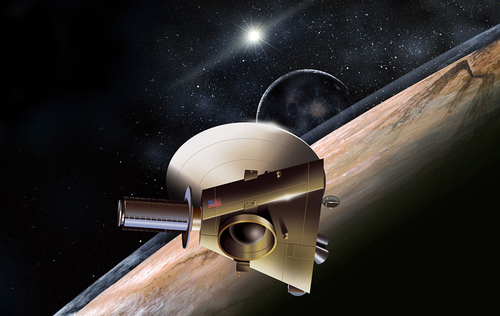Solar Wind Shock Wave Gives Ions a Push
Space is a windy place, with a constant gale of high-energy particles blowing out from the Sun. As this “solar wind” expands, it imparts energy to interstellar atoms and molecules that are continuously flowing into our Solar System. Now researchers have used instruments onboard an interplanetary spacecraft to measure this energy exchange inside a solar wind shock wave as it passed beyond the orbit of Pluto. Their results indicate that shock waves give a significant energy boost to ionized interstellar atoms, while solar wind particles caught up in the wave actually suffer an energy loss. The finding provides an important puzzle piece in understanding the origin of high-energy particles in the outer Solar System.
The solar wind consists of fast-moving charged particles—mostly electrons and protons—that spread out to form a 19-billion-kilometer-wide cloud around the Sun. Intermixed with this cloud is a stream of neutral atoms that come from outside our Solar System. When these interstellar voyagers interact with solar wind particles, they can be ionized and accelerated in a process known as pickup. Scientists know that this process happens, but they don’t have all the details. Determining when and how so-called pickup ions are energized would help astrophysicists reconstruct the history of these ions and would shed light on the interstellar medium from which they originate. Moreover, studying energy transfer processes in our solar neighborhood could provide clues about what is happening around other stars.
One possible source for energizing pickup ions is a solar wind shock wave. These shock waves occur when a fast-moving pulse of solar wind particles plows into the rest of the slower-moving solar wind. Such a pulse can be created by a solar flare or other kind of solar eruption, for example. Particles in “fast” solar wind can travel up to two times faster than those in “slow” wind, which still zips along at speeds more than 1000 times faster than the speed of sound in air. The wave crest, where fast ions hit slower ones, is a compressed band of wind that has increased pressure, density, and temperature compared to the surrounding solar wind.
In 1996, theorists predicted that at large distances from the Sun, solar wind shock waves would impart significant energy to pickup ions they encounter [1]. The prediction indicated that pickup ions would provide the primary mechanism by which solar wind shock waves lose energy as they travel out through the Solar System, says Gary Zank of the University of Alabama in Huntsville, one of the scientists who made the prediction. Measurements made by the two Voyager space probes, which have both had multiple solar wind shock wave encounters during their 40 odd years in space, hinted that the prediction might be correct. But the spacecraft couldn’t confirm the prediction, as neither has instruments capable of detecting pickup ions.
Enter NASA’s New Horizons spacecraft, which launched in 2006. This probe is fitted with a spectrometer called SWAP—Solar Wind Around Pluto—that was specifically designed to measure how pickup ions interact with the solar wind. At Pluto’s distance from the Sun, pickup ions move faster and have a wider range of speeds than the ions in the solar wind, says Eric Zirnstein of Princeton University, who, along with colleagues, has been studying SWAP’s data. SWAP distinguishes the two ion populations by separating incoming particles into energy bins.
Analyzing data taken by SWAP on 5 October 2015, the team observed a transient jump in the solar wind speed from 380 km/s to 440 km/s, indicating the arrival of a shock wave. Data taken before and after the event show that pickup ions gained more than 30% in energy, whereas solar wind ions experienced an 85% energy decrease. The team also observed that the pickup-ion energies remained above normal in the wake of the shock wave and only after three days did this high-energy “tail” disappear. The results confirm theoretical predictions that the faster-moving pickup ions are more effective at extracting energy from shock waves than the slower-moving solar wind ions, explains Zirnstein.
These measurements are important for understanding how different particles interact in our Solar System, says Zank. Joe Giacalone, who studies high-energy particle physics at the University of Arizona, agrees. He is particularly interested in the observed high-energy pickup-ion tail and its role in delivering energy to particles. “It would be really great if we could grab each particle and ask it about its past and how it came to be,” Giacalone says. “This study takes us a step closer to being able to do that.”
This research is published in Physical Review Letters.
–Katherine Wright
Katherine Wright is the Deputy Editor of Physics Magazine.
References
- G. P. Zank, H. L. Pauls, I. H. Cairns, and G. M. Webb, “Interstellar pickup ions and quasi-perpendicular shocks: Implications for the termination shock and interplanetary shocks,” J. Geophys. Res.: Space Phys. 101, 457 (1996).





